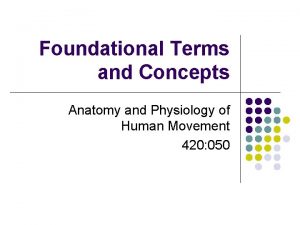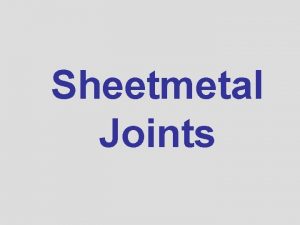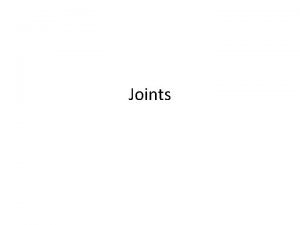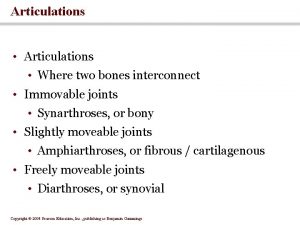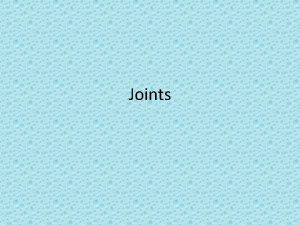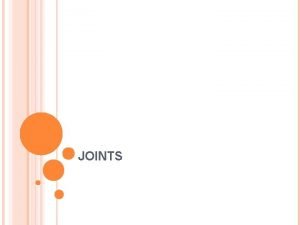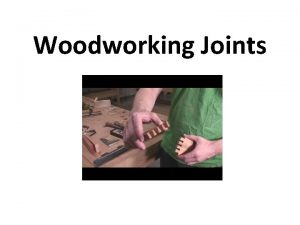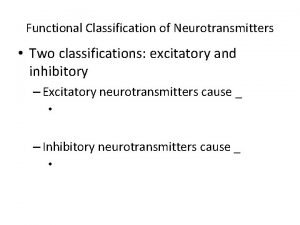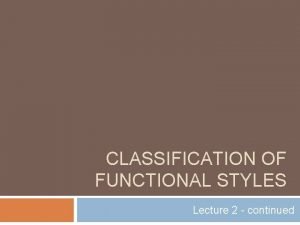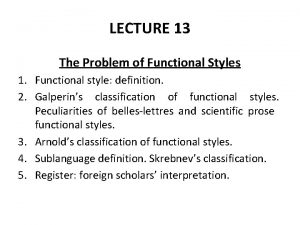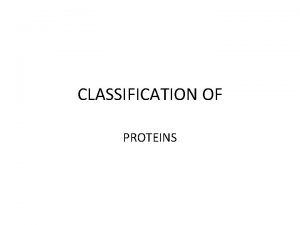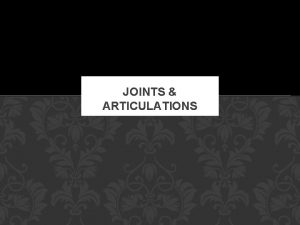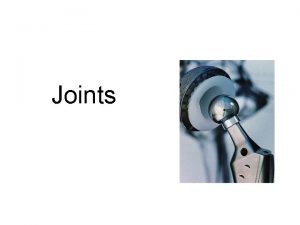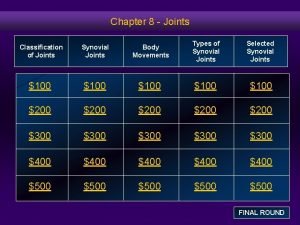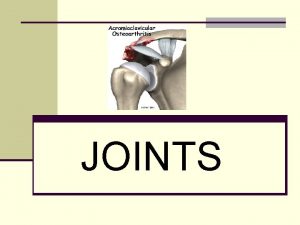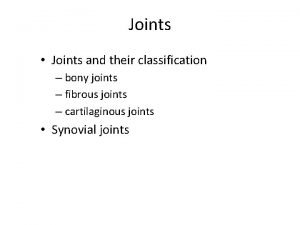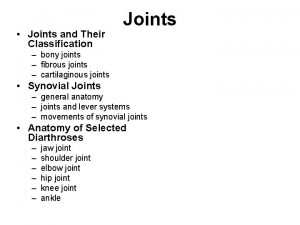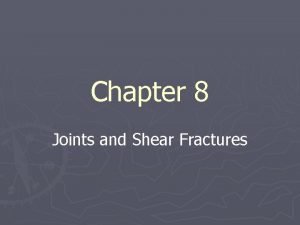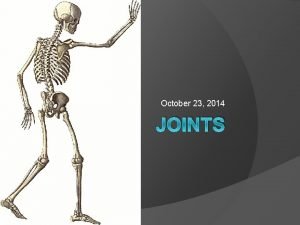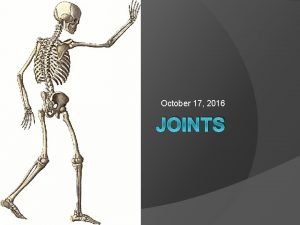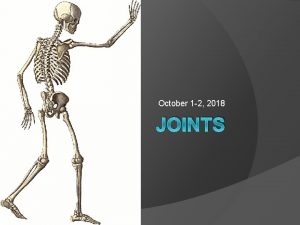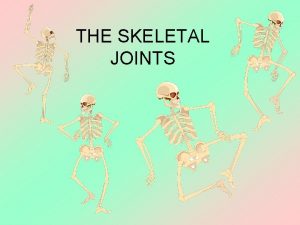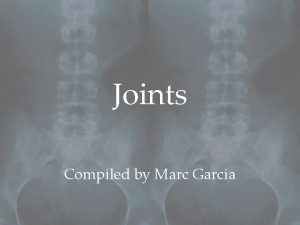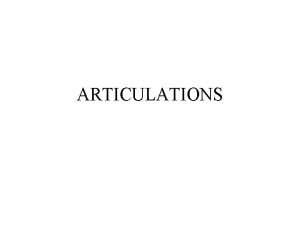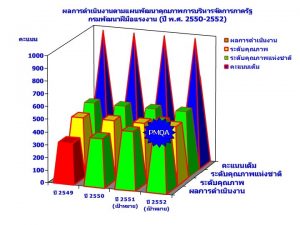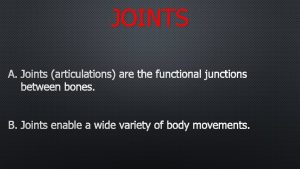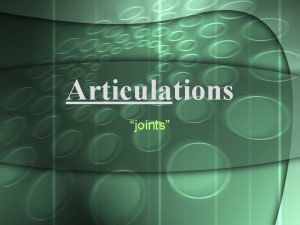Self Assessment Chapter 8 Functional Classification Joints can







































- Slides: 39

Self Assessment Chapter 8

Functional Classification Joints can be classified by how much motion they allow: • _______ – does not allow any movement between articulating bones • ________ – allows only a small amount of movement between articulating bones • _______ – freely moveable, allowing a wide variety of specific movements © 2016 Pearson Education, Inc.

Functional Classification Joints can be classified by how much motion they allow: • Synarthrosis – does not allow any movement between articulating bones • Amphiarthrosis – allows only a small amount of movement between articulating bones • Diarthrosis – freely moveable, allowing a wide variety of specific movements © 2016 Pearson Education, Inc.

Structural Classification Joints can be classified based on their structural features. • ______– fastened together by dense regular collagenous connective tissue without a joint space between articulating bones; can be synarthroses or amphiarthroses • ______– fastened together with cartilage without a joint space; can be synarthroses or amphiarthroses • _______– diarthrosis joints have a layer of hyaline cartilage on articulating surface of each bone; joint space is a fluid-filled cavity found between articulating bones © 2016 Pearson Education, Inc.

Structural Classification Joints can be classified based on their structural features. • Fibrous joints – fastened together by dense regular collagenous connective tissue without a joint space between articulating bones; can be synarthroses or amphiarthroses • Cartilaginous joints – fastened together with cartilage without a joint space; can be synarthroses or amphiarthroses • Synovial joints – diarthrosis joints have a layer of hyaline cartilage on articulating surface of each bone; joint space is a fluid-filled cavity found between articulating bones © 2016 Pearson Education, Inc.

• ______ – immoveable joint between edges of bones that make up cranium; fully fused sutures are very stable, well suited for protecting brain Figure 8. 1 a The three types of fibrous joints. © 2016 Pearson Education, Inc.

Sutures • Suture – immoveable joint between edges of bones that make up cranium; fully fused sutures are very stable, well suited for protecting brain Figure 8. 1 a The three types of fibrous joints. © 2016 Pearson Education, Inc.

• _____– immoveable joint between each tooth and its bony socket in jaw; periodontal ligament is a strong fibrous membrane that links tooth firmly to jaw bone Figure 8. 1 b The three types of fibrous joints. © 2016 Pearson Education, Inc.

Gomphoses • Gomphosis – immoveable joint between each tooth and its bony socket in jaw; periodontal ligament is a strong fibrous membrane that links tooth firmly to jaw bone Figure 8. 1 b The three types of fibrous joints. © 2016 Pearson Education, Inc.

• ______– joint between tibia, fibula, ulna, and radius; bones are joined by an interosseous membrane or ligament composed of dense regular collagenous connective tissue, which allows for small amount of movement Figure 8. 1 c The three types of fibrous joints. © 2016 Pearson Education, Inc.

Syndesmoses • Syndesmosis – joint between tibia, fibula, ulna, and radius; bones are joined by an interosseous membrane or ligament composed of dense regular collagenous connective tissue, which allows for small amount of movement Figure 8. 1 c The three types of fibrous joints. © 2016 Pearson Education, Inc.

• _______ consists of bones linked together by hyaline cartilage; examples are synarthroses (Figure 8. 2 a): • Epiphyseal plates – composed of hyaline cartilage that connects diaphyses and epiphyses of developing long bones; replaced with bone during maturation (Figure 8. 2 a) • First sternocostal and costochondral joints are synchondroses that persist into adulthood (Figure 8. 2 b) • Type of cartilaginous joint © 2016 Pearson Education, Inc.

Synchondroses • Synchondrosis consists of bones linked together by hyaline cartilage; examples are synarthroses (Figure 8. 2 a): • Epiphyseal plates – composed of hyaline cartilage that connects diaphyses and epiphyses of developing long bones; replaced with bone during maturation (Figure 8. 2 a) • First sternocostal and costochondral joints are synchondroses that persist into adulthood (Figure 8. 2 b) Type of cartilaginous joint © 2016 Pearson Education, Inc.

• ______– joint where bones are united by a fibrocartilaginous pad or plug; functionally an amphiarthrosis (Figure 8. 2 b, c, d) • Example of Structure-Function Core Principle; best suited for regions of skeleton that must resist compression • Intervertebral joints – between adjacent vertebral bodies of spinal column (Figure 8. 2 c) • Pubic symphysis – between pubic bones of pelvic girdle (Figure 8. 2 d) • Type of cartilaginous joint © 2016 Pearson Education, Inc.

Symphyses • Symphysis – joint where bones are united by a fibrocartilaginous pad or plug; functionally an amphiarthrosis (Figure 8. 2 b, c, d) • Example of Structure-Function Core Principle; best suited for regions of skeleton that must resist compression • Intervertebral joints – between adjacent vertebral bodies of spinal column (Figure 8. 2 c) • Pubic symphysis – between pubic bones of pelvic girdle (Figure 8. 2 d) Type of cartilaginous joint © 2016 Pearson Education, Inc.

Synovial Joints • Structural Elements (Figure 8. 3): • ________– space found between articulating bones • _________– double-layered structure © 2016 Pearson Education, Inc.

Structural Elements • Structural Elements (Figure 8. 3): • Joint cavity (synovial cavity) – space found between articulating bones • Articular capsule – double-layered structure © 2016 Pearson Education, Inc.

Structural Elements Figure 8. 3 Structure of a typical synovial joint. © 2016 Pearson Education, Inc.

Structural Elements • Synovial fluid – thick liquid with the 3 main functions: 1. Provides _____– reduces friction between articulating surfaces of a joint 2. Serves a ______; provides a means for _______of nutrients and waste products in absence of blood vessels within joint 3. Provides for __________; helps to evenly distribute stress and force placed on articular surfaces during movement © 2016 Pearson Education, Inc.

Structural Elements • Synovial fluid – thick liquid with the following 3 main functions: • Provides lubrication – reduces friction between articulating surfaces of a joint • Serves a metabolic function; provides a means for transportation of nutrients and waste products in absence of blood vessels within joint • Provides for shock absorption; helps to evenly distribute stress and force placed on articular surfaces during movement © 2016 Pearson Education, Inc.

Stabilizing and Supporting Factors • Synovial joints allow ______mobility but are _____stable than other joint types; the following structures provide additional stabilization (Figure 8. 4): • _____– strand of dense, regular, collagenous connective tissue; links one bone to another; provides additional strength and reinforcement to a joint Continue through the slides for other structures that provide additional stabilization © 2016 Pearson Education, Inc.

Stabilizing and Supporting Factors • Synovial joints allow more mobility but are less stable than other joint types; the following structures provide additional stabilization (Figure 8. 4): • Ligament – strand of dense, regular, collagenous connective tissue; links one bone to another; provides additional strength and reinforcement to a joint Continue through the slides for other structures that provide additional stabilization © 2016 Pearson Education, Inc.

Stabilizing and Supporting Factors • ____ – structural component of skeletal muscle; composed of dense regular collagenous connective tissue and connects muscle to bone • Tendons cross associated joints; provide stabilization when muscles are contracted • _______– continuous level of muscle contraction; provides a stabilizing force • Continue through the slides for other structures that provide additional stabilization © 2016 Pearson Education, Inc.

Stabilizing and Supporting Factors • Tendon – structural component of skeletal muscle; composed of dense regular collagenous connective tissue and connects muscle to bone • Tendons cross associated joints; provide stabilization when muscles are contracted • Muscle tone – continuous level of muscle contraction; provides a stabilizing force • Continue through the slides for other structures that provide additional stabilization © 2016 Pearson Education, Inc.

Stabilizing and Supporting Factors • ______ and _____also provide stabilization forces in high stress regions • _______– synovial fluid-filled fibrous structure helps to minimize friction between all moving parts associated with joints • _____ – long bursa that surrounds tendons; protects tendons as they slide across joint during movement © 2016 Pearson Education, Inc.

Stabilizing and Supporting Factors • Bursae and tendon sheaths also provide stabilization forces in high stress regions • Bursa – synovial fluid-filled fibrous structure helps to minimize friction between all moving parts associated with joints • Tendon sheath – long bursa that surrounds tendons; protects tendons as they slide across joint during movement © 2016 Pearson Education, Inc.

Stabilizing and Supporting Factors Figure 8. 4 Supportive structures of©a 2016 synovial joint. Pearson Education, Inc.

Functional Classes of Synovial Joints • Bones in a synovial joint move in different planes around an axis or axes; different possible joint configurations include: • _____– allow motion to occur in one or more planes without moving around an axis • _____– allow motion around only one axis • _____– allow motion around two axes • _____– allow motion around three axes © 2016 Pearson Education, Inc.

Functional Classes of Synovial Joints • Bones in a synovial joint move in different planes around an axis or axes; different possible joint configurations include: • Nonaxial joints – allow motion to occur in one or more planes without moving around an axis • Uniaxial joints – allow motion around only one axis • Biaxial joints – allow motion around two axes • Multiaxial (triaxial) joints – allow motion around three axes © 2016 Pearson Education, Inc.

• ______: amount of movement joint is capable of under normal circumstances © 2016 Pearson Education, Inc.

Range of Motion • Range of Motion: amount of movement joint is capable of under normal circumstances • When you move your knee joint from a relaxed state to full flexion, and then return joint to its fully extended state, that is range of motion of knee • Uniaxial joints (such as knee) tend to have smallest range of motion; multiaxial joints (such as shoulder) tend to have greatest © 2016 Pearson Education, Inc.

Four General Types of movement can take place at synovial joints • 1. • 2. • 3. • 4.

Four General Types of movement can take place at synovial joints • 1. Gliding • 2. Angular • 3. Rotation • 4. Special

Types of Synovial Joints • Plane joint (gliding joint) – most simple and least mobile articulation between flat surfaces of two bones Figure 8. 11 a The six types of synovial joints and the motion allowed at each. © 2016 Pearson Education, Inc.

Types of Synovial Joints • Hinge joint – convex articular surface of one bone interacts with concave depression of a second bone; allows for uniaxial movement Figure 8. 11 b The six types of synovial joints and the motion allowed at each. © 2016 Pearson Education, Inc.

Types of Synovial Joints • Pivot joint – rounded end surface of one bone fits into a groove on surface of a second bone, allowing for uniaxial movement in which one bone pivots or rotates around other Figure 8. 11 c The six types of synovial joints and the motion allowed at each. © 2016 Pearson Education, Inc.

Types of Synovial Joints • Condylar or ellipsoid joint – biaxial joint where oval, convex surface of one bone fits into a shallow, concave articular surface of a second bone Figure 8. 11 d The six types of synovial joints and the motion allowed at each. © 2016 Pearson Education, Inc.

Types of Synovial Joints • Saddle joint – each bone’s articulating surface has both a concave and convex region; allows a great deal of motion for a biaxial joint Figure 8. 11 e The six types of synovial joints and the motion allowed at each. © 2016 Pearson Education, Inc.

Types of Synovial Joints • Ball-and-socket joint – multiaxial articulation in which articulating surface of one bone is spherical and fits into a cup-shaped depression in second bone; allows for a wide range of motion in around all three available axes Figure 8. 11 f The six types of synovial joints and the motion allowed at each. © 2016 Pearson Education, Inc.
 Figure 6-2 structure of a typical bone
Figure 6-2 structure of a typical bone Pivot joint
Pivot joint Body planes and axes
Body planes and axes Actual self meaning and example
Actual self meaning and example Sheet metal joint
Sheet metal joint Functional and non functional space maintainer
Functional and non functional space maintainer Non functional plasma enzymes
Non functional plasma enzymes Functional and non functional plasma enzymes
Functional and non functional plasma enzymes Functional and non functional
Functional and non functional Ellipsoid joints
Ellipsoid joints Structural classification of joints
Structural classification of joints Bone revolves around its own longitudinal axis
Bone revolves around its own longitudinal axis Structural classification of joints
Structural classification of joints Pivot joint
Pivot joint Practical functional assessment hanley
Practical functional assessment hanley Pms scale
Pms scale 5 a's of functional assessment
5 a's of functional assessment Pcmhi model
Pcmhi model Aircraft functional hazard assessment
Aircraft functional hazard assessment Functional assessment
Functional assessment Functional assessment
Functional assessment Dado joint definition
Dado joint definition Functional classification of neurotransmitters
Functional classification of neurotransmitters Classification of functional styles
Classification of functional styles Benjamin classification
Benjamin classification Functional styles
Functional styles Functional classification of protein
Functional classification of protein David annotation tool
David annotation tool Labial bow function
Labial bow function Functional classification of neurons
Functional classification of neurons Self image vs self perception
Self image vs self perception Self concept vs self esteem
Self concept vs self esteem Self concept vs self esteem
Self concept vs self esteem Self concept vs self esteem
Self concept vs self esteem An idealized image that we have developed over time
An idealized image that we have developed over time I self and me self difference
I self and me self difference Contoh ideal self dan real self
Contoh ideal self dan real self Procedural self
Procedural self Eyfs
Eyfs Thomas reid brave officer
Thomas reid brave officer


